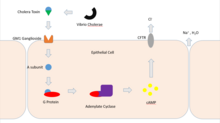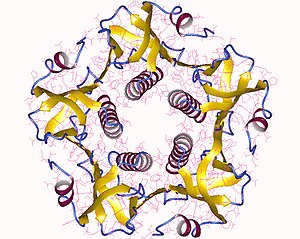霍乱毒素

霍乱毒素(英语:Cholera toxin,又称为英语:choleragen,有时简称为CTX、Ctx 或 CT)是霍乱弧菌分泌的AB5多聚体蛋白质复合体。[1][2]霍乱毒素是造成霍乱感染特有的大量水泻的原因。[3]它是耐热肠毒素家族的成员。
历史
[编辑]罗伯特·科赫是一位德国医生和微生物学家,他是第一个提出霍乱毒素存在的人。1886年,科赫提出霍乱弧菌会分泌一种导致霍乱症状的物质。[4]科赫的推测被印度微生物学家 Sambhu Nath De 证实是正确的,他在1951年研究并记录了用热杀霍乱弧菌注射兔子的效果。[5]他从这个实验中得出结论:细菌分解时释放出来的内毒素是导致霍乱症状的原因。[5]1959年,De 进行了另一项实验,这次他使用无菌的霍乱弧菌培养滤液注入兔子的小肠。[6]结果肠内积液确实证明了毒素的存在。[7]
结构
[编辑]
完整的毒素是由一份A亚基(A部分,酶,UniProt P01555)和五份B亚基(B部分,受体结合,UniProt P01556)组成的六聚体,表示为AB5。B亚基结合,而A亚基则活化 G蛋白,进而活化腺苷酸环化酶。该毒素的三维结构是由 Zhang 等人在1995年使用X射线晶体学测定的。[8]
五个各重11 kDa的B亚基构成一个五元环。28 kDa的A亚基有两个重要的区段。A1部分的链 (CTA1) 是球状的酶载荷,可二磷酸腺苷核糖基化化G蛋白,而A2链 (CTA2) 则形成延伸的α螺旋,紧贴在B亚基环的中央孔隙中。[9]
这种结构在形状、机制和序列上与大肠杆菌某些菌株所分泌的耐热肠毒素家族类似。
致病机制
[编辑]霍乱毒素的作用机制如下: 首先,霍乱毒素的B亚基环与目标细胞表面的GM1神经节苷脂结合。如果细胞缺乏GM1,毒素很可能会与其他类型的聚糖结合,例如附着在蛋白质上的Lewis Y和Lewis X,而不是脂质。[10][11][12] 一旦结合,整个毒素复合物会被细胞内吞,二硫桥的还原会释放霍乱毒素A1 (CTA1) 链。胞内体被移动到高尔基体,在那里A1蛋白被内质网 (ER) 分子伴侣蛋白二硫异构酶(protein disulfide-isomerase)识别。A1链随后展开并被送到膜上,在膜上,Ero1触发蛋白质二硫化异构酶复合物氧化,释放A1蛋白。[13]当A1蛋白透过Sec61通道从内质网移动到细胞质时,它会重新折叠,避免因泛素化而失去活性。
参见
[编辑]参考资料
[编辑]- ^ Ryan KJ; Ray CG (编). Sherris Medical Microbiology 4th. McGraw Hill. 2004: 375. ISBN 978-0-8385-8529-0.
- ^ Faruque, Shah M; Nair, G. Balakrish (编). Vibrio cholerae: Genomics and Molecular Biology. Caister Academic Press. July 2008 [2024-12-22]. ISBN 978-1-904455-33-2. (原始内容存档于2024-03-03).
- ^ Aizpurua-Olaizola, Oier; Sastre Torano, Javier; Pukin, Aliaksei; Fu, Ou; Boons, Geert Jan; de Jong, Gerhardus J.; Pieters, Roland J. Affinity capillary electrophoresis for the assessment of binding affinity of carbohydrate-based cholera toxin inhibitors. Electrophoresis. 2018, 39 (2): 344–347. ISSN 1522-2683. PMID 28905402. S2CID 33657660. doi:10.1002/elps.201700207 (英语).
- ^ Bharati, Kaushik; Ganguly, Nirmal K. Cholera toxin: A paradigm of a multifunctional protein. The Indian Journal of Medical Research. February 2011, 133 (2): 179–187. ISSN 0971-5916. PMC 3089049
 . PMID 21415492.
. PMID 21415492.
- ^ 5.0 5.1 De, S. N.; Sarkar, J. K.; Tribedi, B. P. An experimental study of the action of cholera toxin. The Journal of Pathology and Bacteriology. 1951, 63 (4): 707–717. PMID 14898376. doi:10.1002/path.1700630417.
- ^ De, S. N. Enterotoxicity of bacteria-free culture-filtrate of Vibrio cholerae. Nature. 1959-05-30, 183 (4674): 1533–1534 [2024-12-22]. ISSN 0028-0836. PMID 13666809. doi:10.1038/1831533a0. (原始内容存档于2024-12-03).
- ^ Bharati, Kaushik; Ganguly, Nirmal K. Cholera toxin: A paradigm of a multifunctional protein. The Indian Journal of Medical Research. February 2011, 133 (2): 179–187. ISSN 0971-5916. PMC 3089049
 . PMID 21415492.
. PMID 21415492.
- ^ Zhang R, Scott D, Westbrook M, Nance S, Spangler B, Shipley G, Westbrook E. The three-dimensional crystal structure of cholera toxin. J Mol Biol. 1995, 251 (4): 563–73 [2024-12-22]. PMID 7658473. doi:10.1006/jmbi.1995.0456
 . (原始内容存档于2024-07-31).
. (原始内容存档于2024-07-31).
- ^ De Haan L, Hirst TR. Cholera toxin: a paradigm for multi-functional engagement of cellular mechanisms (Review). Mol. Membr. Biol. 2004, 21 (2): 77–92. PMID 15204437. S2CID 22270979. doi:10.1080/09687680410001663267
 .
.
- ^ Amberlyn M Wands; Akiko Fujita. Fucosylation and protein glycosylation create functional receptors for Cholera toxin. eLife. October 2015, 4: e09545. PMC 4686427
 . PMID 26512888. doi:10.7554/eLife.09545
. PMID 26512888. doi:10.7554/eLife.09545  .
.
- ^ Cervin J, Wands AM, Casselbrant A, Wu H, Krishnamurthy S, Cvjetkovic A, et al. GM1 ganglioside-independent intoxication by Cholera toxin. PLOS Pathogens. 2018, 14 (2): e1006862. PMC 5825173
 . PMID 29432456. doi:10.1371/journal.ppat.1006862
. PMID 29432456. doi:10.1371/journal.ppat.1006862  .
.
- ^ Wands AM, Cervin J, Huang H, Zhang Y, Youn G, Brautigam CA, Matson Dzebo M, Björklund P, Wallenius V, Bright DK, Bennett CS, Wittung-Stafshede P, Sampson NS, Yrlid U, Kohler JJ. Fucosylated Molecules Competitively Interfere with Cholera Toxin Binding to Host Cells. ACS Infectious Diseases. February 7, 2018, 4 (5): 758–770. PMC 5948155
 . PMID 29411974. doi:10.1021/acsinfecdis.7b00085.
. PMID 29411974. doi:10.1021/acsinfecdis.7b00085.
- ^ Tsai, Billy; Rapoport, Tom A. Unfolded cholera toxin is transferred to the ER membrane and released from protein disulfide isomerase upon oxidation by Ero1. Journal of Cell Biology. 2002, 159 (2): 207–216. PMC 2173060
 . PMID 12403808. S2CID 3111310. doi:10.1083/jcb.200207120.
. PMID 12403808. S2CID 3111310. doi:10.1083/jcb.200207120.
外部链接
[编辑]- De, Sambhu Nath. Enterotoxicity of bacteria-free culture filtrate of Vibrio cholerae (页面存档备份,存于互联网档案馆). Nature. 30 May 1959. 183:1533–4.
- McDowall, Jennifer. Cholera toxin. Protein of the Month (POTM). Protein Data Bank in Europe (PDBe). Sep 2005. (原始内容存档于April 27, 2019).
- Goodsell, David. Cholera Toxin. RCSB Protein Data Bank. Molecule of the Month (MOTM) (Protein Data Bank (PDB)). Sep 2005. doi:10.2210/rcsb_pdb/mom_2005_9. (原始内容存档于October 25, 2011).
- 医学主题词表(MeSH):Cholera+Toxin
- PDB中UniProt可用的所有结构信息之概述:P01555 (Cholera enterotoxin subunit A) 在PDBe-KB。
- PDB中UniProt可用的所有结构信息之概述:P01556 (Cholera enterotoxin subunit B) 在PDBe-KB。
